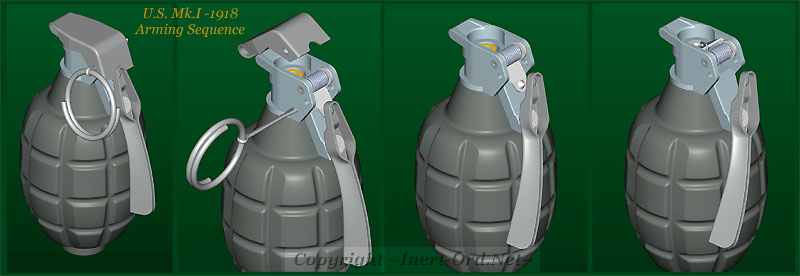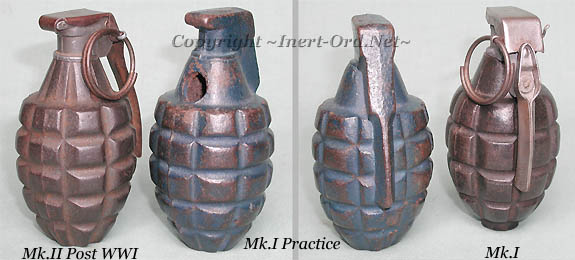
Evidently the U.S. War Department was of strong opinion that young
American males of 1918 would find pitching a baseball to be an almost natural
act, hence, incorporating that "inherent" skill into the function of this
grenade would be a clever thing to do.
To operate, the grenade was held in the right hand, the thumb crossing over the lever, the high ridge nested in the crevice of the thumb's first joint.
The pin is removed and the top cap shaken off the grenade.
With an over hand throw, the lever was intended to be "automatically" twisted, by the thumb, as the grenade rolled off the palm of the hand. At about a 20° angle the lever frees the cocked striker which snaps like a mousetrap, initiating the primer and lighting the 5 second fuze.
Soldiers were already familiar with the French F1 and British Mills, which only required a simple release of the safety lever, without any regard to throwing technique. Having to adjust to the curious mechanical features of the Mk.I was no doubt often forgotten in the heat of battle.
If operated as the other grenades, the Mk.I would be thrown in a safe condition. The enemy merely had to pick it up, twist the lever and throw it back. Since many German grenades required manual arming while still in the hand, the Mk.I design was probably more comfortable for their use than for Americans.
To operate, the grenade was held in the right hand, the thumb crossing over the lever, the high ridge nested in the crevice of the thumb's first joint.
The pin is removed and the top cap shaken off the grenade.
With an over hand throw, the lever was intended to be "automatically" twisted, by the thumb, as the grenade rolled off the palm of the hand. At about a 20° angle the lever frees the cocked striker which snaps like a mousetrap, initiating the primer and lighting the 5 second fuze.
Soldiers were already familiar with the French F1 and British Mills, which only required a simple release of the safety lever, without any regard to throwing technique. Having to adjust to the curious mechanical features of the Mk.I was no doubt often forgotten in the heat of battle.
If operated as the other grenades, the Mk.I would be thrown in a safe condition. The enemy merely had to pick it up, twist the lever and throw it back. Since many German grenades required manual arming while still in the hand, the Mk.I design was probably more comfortable for their use than for Americans.




